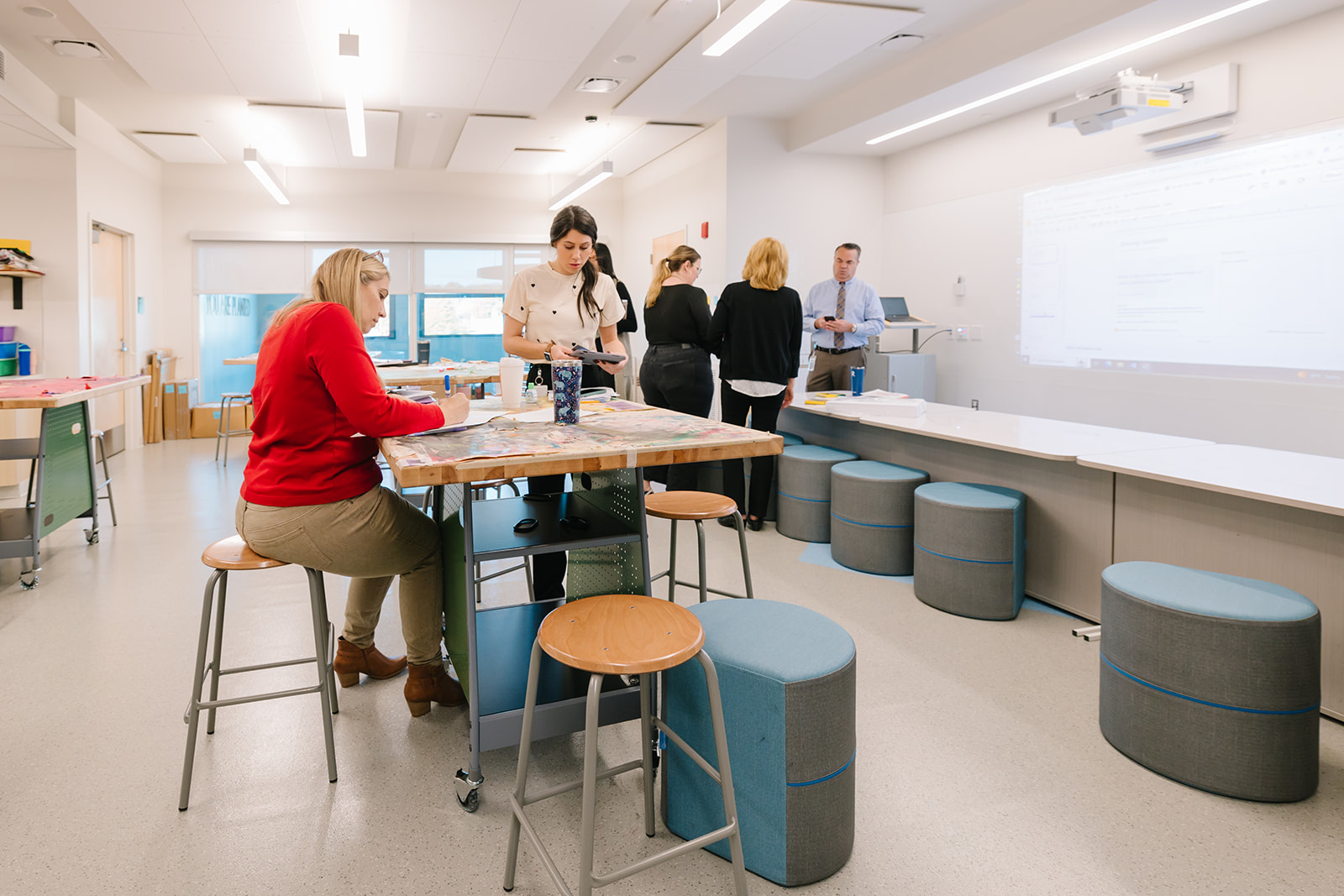
Notes from the Global Learning Commons
In a profession where nurturing growth is the very essence of the job, it’s crucial that school leaders also focus on cultivating the well-being, development, and collaborative skill sets of their staff. As the backbone of educational institutions, teachers deserve a working environment that not only recognizes their dedication, but also actively supports their professional journey. How can school leaders turn this ideal into practice?
We’ll explore three transformative ways school leaders can uplift their staff:
Well-being: We’ll delve into how frequent, transparent communication and even the development of better emails can lay the groundwork for a supportive culture. We’ll also discuss the importance of “rounding,” or regular check-ins, to keep the pulse of the staff’s well-being.

Professional Development: Creating a culture of learning is not just for students. We’ll look at how sharing stories, learning alongside staff, and embracing a coaching model can enhance the professional growth of teachers.
Collaboration: Collaboration is the lifeblood of a dynamic school environment. We’ll examine the structures and systems that enable fruitful collaboration: from providing time and space, to encouraging a culture of trust and iterative learning.
Strategies to Support Staff Well-being
Frequent and Transparent Communication: Ensuring that communication is open, clear, and regular
- Develop Better Emails: Write emails with a summary at the top and encouraging photos at the bottom. Include action items.
- “Rounding”: Regularly scheduled check-ins with staff to discuss what’s working and what isn’t. You can also achieve this with a mentor system
- Use Chat GPT: Encourage teachers to utilize AI tools like Chat GPT to make email communication easier.
- District Norms: Establish regular intervals for sharing findings between the administration team and staff.
Create Connections
- Radical Trust: Establish a deep level of trust within the team.
- Gather Feedback: Collect feedback from staff and understand that not everything needs to be implemented.
- Sharing Control: Explore how to share responsibilities and control with the team.
- Empowerment: Enable staff to have pathways for action.
Normalize Support
- Communicate a Supportive Culture: Make it clear that it’s acceptable to ask for help.
- “Tapping Out”: Encourage staff to ask for support when needed.
Strategies on how to Support Staff Professional Development
Create a Culture of Learning for Adults
- Share stories: Find ways to encourage teachers to share their personal teaching stories.
- Schoolwide Screenings: Organize school wide screenings of educational documentaries.
- Learn Alongside Staff: Administrators should engage in learning activities with their staff.
- Book Clubs: Encourage the formation of book clubs as a means of professional development.
- Define Our Why: Help teachers articulate the purpose behind their teaching methods.
- Empathize with Extreme Users: Encourage empathy for users with the most significant needs.
Implement Structures and Systems to Promote and Facilitate Learning
- Coaching Model: Adopt a coaching model that provides support and time for implementation.
- Protocols for Discussion and Reflection: Establish protocols to guide discussion and reflection.
- Flexibility: Provide a flexible environment that accommodates various professional development activities.

Make and Find the Time… it is that important and it will make a difference
- Time and space for new tools: Make time and space for teachers to experiment with different pedagogical tools and prototyping, like SOLE (Self-Organized Learning Environments).
- Prioritize Conversations: Help teachers allocate time for conversations on how to improve their teaching practice.
- Common Planning Times: Schedule common planning times for teachers to collaborate.
“Get Out of the Way,” as leaders, help remove barriers and make sure you aren’t creating new ones
- Trust in Staff Learning: Trust staff to learn and implement new strategies without micromanaging.
- Support the Coalition of the Willing: Back the group of teachers eager to implement new ideas.
- Self-Created PD Teams: Form interdisciplinary teams for professional development, give educators choice.
Get Out of the Box, go off campus and rethink space
- Site Visits: Encourage and create opportunities for teachers to visit other educational sites.
- Reinvent School Settings: Transform traditional school settings to offer a variety of learning environments.
- Team Building Activities: Conduct team building activities to strengthen staff relationships.
- Inspiring Meeting Places: Meet in places that inspire creativity and organize trips to other inspiring locations.
Strategies on how to Support Staff Collaboration
Give Time
- Providing Time Specifically for Collaboration: Allocate specific times for staff to work together.
- Networking Team: Establish dedicated times for check-ins.
- Structural Time: Align the structure of the school day to provide time for collaboration.
- Common Goals: Schedule the same planning time for everyone on a team to work together.
Communication Within and Beyond Teaching Teams
- Effective Internal Communication: Ensure everyone is on the same page and run through scenarios as a team.
- Responsive Support: Listen to team needs and offer support for what they need or want.
- Ecosystem Beyond the Classroom: Recognize that collaboration extends to the community and stakeholders outside the classroom walls.
Celebrate People
- Getting to Know Staff: Understand staff dynamics to create effective teams.
- Focusing on Strengths: Build teams where each person’s strengths are known, trusted and utilized.
- Valuing Conversations: Understand what staff want from their collaborative time and adjust accordingly.
Agency and Accountability
- Agency for Adults: Empower staff with the ability to make their own decisions.
- Accountability: Ensure that everyone is held responsible for their part in the collaboration.
Space to Play Together
- Shared Spaces: Encourage staff to work together in shared spaces and to support each other.
- Dedicated Space: Provide a physical space for staff to collaborate effectively.
Trust, Bravery, and Iteration All Hold Hands
- Trust Among Teachers: Create a safe environment for teachers to take risks and work together.
- Learning from Failure: Encourage teams to learn from failures and explore different directions.
- Peer Introductions: Allow teachers to introduce new ideas to each other, contributing to the collective knowledge.
Well-being, collaboration, and professional development address different areas of supporting staff but these three areas share some common themes: time, trust, communication, and agency.
For teachers to take on the many hats that they are asked to wear, they need intentionally structured time. That means that school leaders need to help carve out that time and protect it, whether it is for collaboration, professional development, or well-being. There is only so much time in a day or a year, so this may mean sacrificing other initiatives. This is an opportunity to re-examine priorities and check for alignment with the mission and vision (don’t forget to make sure your mission and vision are in good working order first).
Trust is a critical component of school culture when you are asking teachers to do so much, including to iterate and to grow. There must be trust in place to create a safe space where teachers can try new techniques and grow their practice. Giving teachers more agency and providing clear, transparent, frequent communication helps build trust. When teachers feel like they have autonomy over their professional trajectory and know what is happening around them and why, it creates a culture of inclusion, transparency, and trust.
By supporting staff in meaningful ways, school leaders can create an ecosystem where educators thrive and, as a result, shape the minds of the future with even greater impact.


